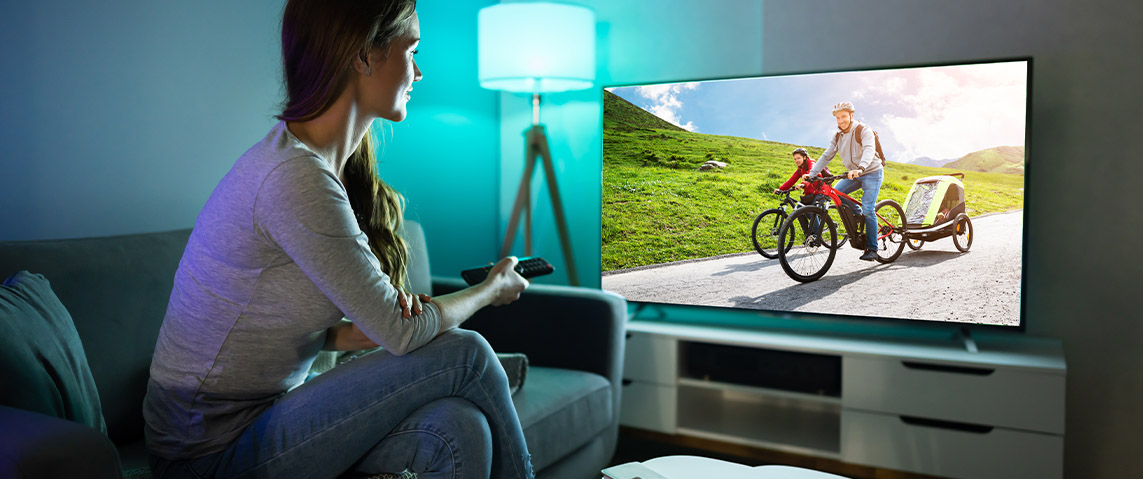Tips For Buying a New TV

In this post, we'll cover
Are you thinking of buying a new television? If your television is four years old or more then you may find that the televisions have changed considerably and many which were top of the range then have come down in price.
One of the first things you may think about when buying a new television is the size of a screen. Many people like a larger television and some of them can make your living room like a home cinema.
Best TV Size
A good size is between 55 and 65 inches. Consider what a large television will look like in your home and how many people will usually be watching it before you make up your mind as to what size television you want. Larger televisions are an excellent choice because they don’t strain the eyes.
OLED televisions are better than LED and LCD televisions but they are more expensive. OLED stands for ‘organic light emitting diode’ and is the latest screen technology.
Most televisions are ‘smart televisions’ these days but it is always worth confirming that what you are buying is a ‘smart television’. Smart televisions (for those that do not know) are those that enable access to a range of online services including video on demand, social networking and instant messaging. Internet access will need to be available for this to happen.
Look for four or more HDMI ports to plug in your accessories.
As many televisions are so narrow do consider buying a sound bar as the sound quality of the television may not be as good as the older televisions that had more room for quality speakers.
Plasma televisions usually have good picture quality and if they are large then can give that ‘home cinema’ feeling as the television can be seen from many different angles.
LCD TVs
LCD televisions tend to be cheaper and are good for basic viewing but cannot be seen from different angles so someone sitting not directly in front of the screen may not be able to see the picture. They are fairly energy efficient.
LED TVs
LED televisions are LCD televisions that use LEDs as a backlight for the liquid crystals in the display. LED televisions use less power than standard LCDs and plasma. Unfortunately, they may be more expensive.
OLED TVs:
Organic Light Emitting Diode televisions as I have mentioned before, are different from LCD televisions. OLED televisions use coloured LED lights to create the image, so they do save on power but not usually as much as LED TVs. They do manage to create a bright high-quality image so they may be best for those planning on watching TV a lot during brighter hours, when glare could otherwise be a problem. They also have high contrast ratios, as black pixels will not be emitting light and they create excellent visuals. OLED screens cost more to make so you will have to pay a bit more. They also suffer from some of the viewing angle problems that effect LCD televisions.
Look around at televisions in stores to see what you like about certain ones and read the reviews of televisions online as they may give you some insight as to which one is the perfect one for you.
Also, it’s worth considering taking out a TV Insurance cover for any unwanted mechanical, electrical or accidental damage. Not all new TV’s come with adequate protection so it worth getting that extra piece of mind.
TV insurance policies can be customized to suit individual needs, with options for varying deductibles, coverage limits, and even extended warranties.
Learn about the protection plans available, including coverage for accidental damage, breakdowns, and other potential risks. Ensure your peace of mind with our detailed insights on what TV insurance covers.
Resolve TV breakdowns with ease using our troubleshooting guide. Explore step-by-step solutions to common issues affecting your TV's performance. Get your television back up and running smoothly by following our comprehensive troubleshooting tips.

 Home Emergency
Home Emergency 
 Home Appliances
Home Appliances 
 Landlord Home Emergency
Landlord Home Emergency 





 Motor Breakdown Cover
Motor Breakdown Cover 


 Infotainment
Infotainment 

 Home Emergency Insurance
Home Emergency Insurance Home Appliance Insurance
Home Appliance Insurance Landlord Home Emergency
Landlord Home Emergency TV Brands
TV Brands